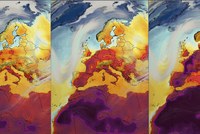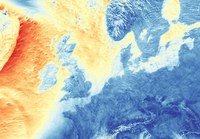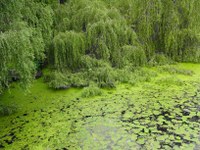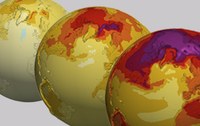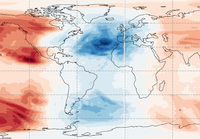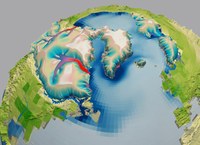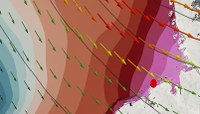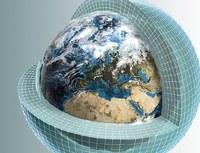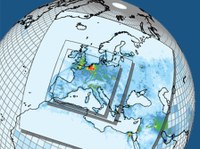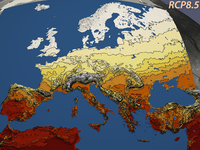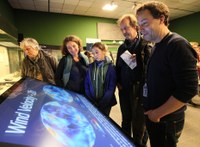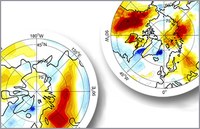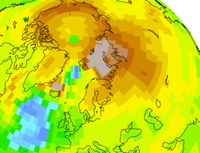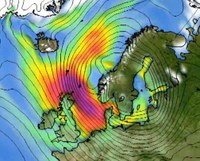Taming the Petabytes: Making km-scale climate data usable
Easy use of global km-scale climate data – the EERIE approach. The German Climate Computing Center (DKRZ) contributes to the EERIE project and has pioneered a data infrastructure for handling the challenges associated with the high volume model output.
Understanding Extreme Events in a Climate Change Context
Europe is experiencing more intense and frequent extreme weather—but how much of it is due to climate change? The project ClimXtreme analyses recent weather extremes, such as Germany’s 2023–2024 winter floods and the May–June 2024 rain event.
Can ambitious Afforestation/Reforestation mitigate temperature overshoot?
Future pathways that are consistent with the Paris Agreement 1.5°C climate target typically include large-scale Carbon Dioxide Removal (CDR) deployment, which facilitates reaching net-zero emissions by compensating for hard-to-abate residual emissions.
Extreme weather events in a changing climate
What would the 2019 summer heatwave in Germany have been like if it had taken place in a cooler climate without human influence? Would the continuous rainfall at the turn of last year, which led to the flooding of large areas of northern Germany, have been less severe without climate change? How would these and other extreme weather situations unfold in a globally 4 °C warmer world? As part of the SCENIC project, the AWI and the KIT are simulating at the DKRZ how observed extreme weather events shift with climate change.
Climate simulations with kilometer resolution
The future of climate modeling has already begun: On DKRZ's Levante computer, the Max Planck Institute for Meteorology (MPI-M) has succeeded for the first time worldwide in performing a simulation with a fully coupled global atmosphere-ocean model with a horizontal resolution of about 1 km.
Levante - a new Supercomputer for Earth System Research
Levante, the new, fourth high-performance computing system for Earth system research (HLRE-4) started its operation on March 3, 2022, at the German Climate Computing Center (DKRZ) in the first expansion stage. The supercomputer, which like its predecessor "Mistral" is provided by the company Atos, quadruples the computing power at DKRZ with 14 PetaFLOPS.
Nobel Prize in Physics for Prof. Klaus Hasselmann - a look back to the future
Back in the 1990s, DKRZ produced science videos on some of the works for which Prof. Hasselmann received the 2021 Nobel Prize in Physics to communicate the results to the public. Let's take a look back together - at the future predictions of the past!
Earth’s greening trend seems to slow down
Satellite observations of the land surface since the early 1980s show that the area of green, living plant leaves in the ecosystems has on average steadily increased during the last decades. Leaf area is described in the so-called "leaf area index" defined in leaf area per ground area (in m² per m²). Satellite sensors determine this quantity based on the reflectance properties of the land surface: If the amount of solar radiation reflected from the land surface in the "photosynthetically active" spectrum is steadily decreasing, it means that the plants are absorbing more solar energy. This suggests how much photosynthetically active area, i.e. green leaf area, must have been added to explain the increased radiation absorption.
Now online: Information on the CMIP6 climate simulations for the sixth IPCC world climate report
In various ways, DKRZ has been involved in the scenario simulations performed in Germany for the model intercomparison project CMIP6 and with regard to the sixth assessment report, AR6, of the Intergovernmental Panel on Climate Change IPCC. The information on the models and climate scenarios used, on compute time, access to output data and numerous visualizations of model results have recently been published on the DKRZ website.
AIM – Machine Learning for Earth System Science
The Helmholtz Association has founded the Helmholtz AI initiative for Artificial Intelligence (AI) and Machine Learning (ML) (Helmholtz AI Cooperation Unit) to develop, implement and establish new application-oriented methods for the analysis of complex systems in the fields of energy, matter, information, transport, climate and health. Helmholtz AI consists of a central unit at Helmholtz Zentrum München (HMGU) and five local research-specific units at other Helmholtz Centers. Helmholtz-Zentrum Geesthacht (HZG) and DKRZ are involved with the unit AIM ("Artificial Intelligence innovates Earth System Analytics and Modelling") for the topic Earth and Environment, which consists of a junior research group at HZG led by Dr. David Greenberg and a support team at DKRZ led by Dr. Tobias Weigel.
From the Last Interglacial to the Anthropocene: Modelling a Complete Glacial Cycle
The PalMod initiative aims to simulate the full last glacial cycle starting from 130.000 years before present using three different Earth System Models (ESMs) and to extend these simulations for at least 2.000 years into the future.
The storm tide in March 1906
Reconstruction of a historic storm tide in March 1906, which still is of relevance for coastal protection in Germany
New Climate Model for the Intergovernmental Panel on Climate Change
How much could the Earth heat up in the coming decades as a result of climate change? How would this change our world? These are some of the most pressing questions of our time, and researchers around the globe are using numerical climate models in an attempt to find answers to them. But Earth’s climate is extremely complex and difficult to model on supercomputers. Each climate model has its specific strengths and weaknesses. In order to realistically estimate the bandwidth of possible future climate developments, the results of all major climate models worldwide are conjointly evaluated and compared. In this way, scientists estimate the uncertainty in the climate projections and derive the most likely answers of the climate system to the given scenarios.
Linking global climate and regional air quality with MECO(n)
Anthropogenic and natural emissions of several trace gases like nitrogen dioxide and volatile organic compounds, carbon monoxide, as well as particle emissions have an effect on both air quality and global climate. Not all trace species have a climate impact, however, they are chemical precursors for the development of tropospheric ozone, which in turn is radiatively active.
Regional Climate Projections for Europe
Global climate change has different regional impacts; its effects are already noticeable today. Mankind will need to adapt to those future changes. To investigate possible regional climate changes in Europe in the 21. Century and to develop adaption strategies, regional climate simulations are performed. The Climate Service Center Germany (GERICS) is involved in the development of various models and methods to provide local climate change information. The simulated model results are stored at the DKRZ and can be downloaded from there through the ESGF (esgf-data.dkrz.de). DKRZ and GERICS have jointly produced animated visualizations showing the projected key changes in temperature and precipitation for Europe during the 21. Century.
What will the next winter be like?
Using a completely new method, the quality of seasonal forecasts for winter can be significantly improved for many parts of Europe. So far, useful predictions have been made especially for the tropics. A team around Dr. Mikhail Dobrynin and Prof. Dr. Johanna Baehr from the Center for Earth System Research and Sustainability (CEN) of the University of Hamburg has published the results in the journal Geophysical Research Letters.
Project Retrograde — imagine Earth rotated in the opposite direction
The rotation of Earth shapes our climate system in various ways: It controls the major wind directions, lets the weather systems swirl, and, together with the topography, it creates strong ocean currents. Many other features of the climate system, like the monsoon systems and the meridional overturning circulation in the ocean arise from complex interactions within the climate system, and their exact dependency on the topography is hard to pinpoint.
Simulating past warm climates: Resolution matters
Aiming at more accurate simulation of physical processes on the local scale, models with higher grid resolution are increasingly being developed. Results of low-resolution models are now complemented by higher-resolved simulations and are often compared with each other in model intercomparison studies like the Paleoclimate Modelling Intercomparison Project (PMIP) (e.g., Braconnot et al., 2012). The dependence of regional and global climate dynamics on grid resolution is therefore of particular interest in numerical simulations.
Two petabytes of data for climate research: The consortia project ESCiMo
A profound understanding of the processes contributing to climate change is an important precondition for developing sustainable future strategies. The successfully completed comprehensive global climate simulations with the Chemistry-Climate model EMAC (ECHAM/MESSy Atmospheric Chemistry; Jöckel et al., 2016) provide an important contribution to this understanding. For the period from 1950 until 2100, both the historical evolution of the atmosphere including its chemical processes as well as scenarios of future developments of the global climate were simulated on the supercomputer of the German Climate Computing Center (DKRZ). The climate data resulting from the model simulations comprise more than two petabytes and will soon be made available to the scientific community.
Impact of air pollution on human health
Every year 3.3 million people die prematurely from the effects of air pollution worldwide - a figure that could double by 2050 if emissions continued to rise at the current rate. However, large efforts have been made in recent years to reduce air pollution over Europe and the USA using stringent regulation. The project will help to estimate the importance of air quality worldwide in terms of human health.
Global high-resolution climate reconstructions
In order to analyze changes of extreme events like, for instance, storms, long and homogeneous time series of weather data are essential. A new global simulation computed with the climate model ECHAM6 provides temporally and spatially highly resolved data for the past decades.
HD(CP)² - Clouds and Precipitation in the climate system
The question whether climate change is man-made is discussed in public for a long time. To assess this more accurately and to evaluate future consequences more reliably, it is necessary to understand the underlying physical processes in greater detail. Processes that are linked to the formation of clouds and development of precipitation play an important role within the climate system. Global and regional distribution of clouds and precipitation determine which regions are habitable and which are not, where agriculture can be successful and where not. For answering such questions, the overall target of the BMBF project HD(CP)² is improving the general understanding of cloud and precipitation processes and implications for climate projections.
MiKlip – advancing decadal climate prediction research
The MiKlip project (short for “decadal climate predictions”) is funded by the German Federal Ministry of Education and Research (BMBF) and pursues research on predicting natural and human-induced climate variability on a time scale of up to 10 years. MiKlip aims at the establishment of an operational decadal climate prediction system. Originally funded for a four-year period, the project has been extended into a second phase, starting now, of three years of additional research, plus one further year for the operational implementation.
REACT4C – Reducing emissions from aviation by changing trajectories for the benefit of climate
Air transportation has an important role in international mobility. However, it also alters the atmospheric composition and thereby contributes to climate change.
WASCAL – Regional Climate Simulations for West Africa
Global climate change is clearly noticeable at regional scales as well, and is one of the main challenges in West Africa in the 21st century. Countries in this region need to develop effective adaptation and mitigation strategies to counteract the negative effects of land use changes and of climate change on the population and on the environment, as, for example, on the hydro-meteorological variability. WASCAL is a research-oriented project aimed at deriving solutions for these challenges. A team of climate modellers in Germany and West Africa is developing a regional climate modelling system (“dynamical downscaling” of global modelling results) specifically for Northwest Africa.




